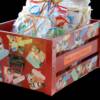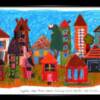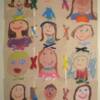Good materials to use:
(remember to look for the Michael's 40% off coupons
in the Sunday Paper to help keep costs down)
Acrylic paint - can be diluted with water to simulate water color but is much more stable.
Mod Podge - great for glueing and sealing artwork - creates a top varnish for the art and is non toxic. All-in-one sealer, glue, and finish used for creating decoupaged works of art. It can be used for paper, wood, fabric, and other porous surfaces. It dries clear and holds tight. You can get it an a variety of styles such as glossy, matte, outdoor, glitter, hard coat, fabric, glow-in-the-dark, and more.
Varnish - clear coating applied to finished projects to protect and enhance it's appearance. Brushed on like paint, it provides a hard, transparent finish to a project and also protects wood finishes and painted surfaces.Look for a varnish that does not "yellow". For a lighter, faster drying protective coating, consider using an acrylic sealant spray.
Spray varnishes - easier to use and less likely to bleed but do not protect as well. Sometimes you might want to spray first with a varnish to "set" the piece and then go over with canned varnish to provide a thicker sealant.
Fixative - A sealer sprayed over pictures and projects to protect the surface from smudging, smearing, and running. It is often used over pastels, charcoal, and even to seal water-based paint and chalk.
Tacky spray - great for gluing paper without creating bubbles or ridges underneath. Use outdoors.
Tacky glue - In the brown bottle. Provides a great permanent clear glue but takes a long time to dry.
Fabric paint / dimensional paint - High quality, "puffy" paint that usually comes in a squeeze bottle for ease of use. It is traditionally used as fabric paint but sticks well to most surfaces.
Blue Painter's tape - great for masking off areas in the art piece. Pulls up easily without pulling up artwork underneath.
Thick sided (1 1/2" - 2" thick) Gallery wrapped canvas - Try to get the thicker canvas that is stapled on the back (not the sides). This way you can paint the edges and can avoid paying for framing. Just wire the back and you're ready to go.
(buy at Michael's with the 40% off coupons from the paper)
Colored pencils, permanent markers or Crayons
Tissue paper, water color paper, wrapping paper, transfer paper
Eye hooks and wire for wiring all pieces.
Quilting or sewing materials:
photographs (be careful if using a varnish that the photo doesn't bleed)
Pottery: platters, cookie jars, dinnerware sets....
Unfinished furniture: bookcase, toy box, game table, rocking chair
Garden furniture: adirondack chairs, picnic table, bird bath, stepping stones, garden bench
Mirrors, old window frame, umbrellas, rug /carpet, mailboxes, birdhouses, flower boxes, treasure chest, shower curtains.....
materials & techniques
Brought to you by the
2010 Morningside Elementary
Kid's Classroom Art
Auction Coordinator
Evelyn Edmeades
Techniques
*google any of these terms to see sample images and get
more information
Decoupage:
Basically, you cut out pictures; you glue the pictures onto an object; and then cover the object and pictures with a few coats of glue/decoupage medium (Mod Podge) to protect it.
Collage:
The word collage comes from the French word ‘coller’ which means 'to glue'. A collage is made by gluing items onto a base. Collage is usually more of a two-dimensional art.
Paper Mache:
To create objects using paper stuck together or onto other objects using using a wet paste (e.g. glue, starch, or wallpaper adhesive). The crafted object becomes hard when the paste dries. This term also refers to the finished project.
Transfer Paper:
A paper that is coated on one side with gray, black, white, blue, or red material that aids in transfering a design to a surface. Paper is placed, color-side down, onto the surface. The desired design is placed on top of transfer paper, and a stylus or pencil is used to trace the design so it transfers onto the surface. Great for all kinds of projects.
Stencil:
A template made by cutting a design into a stiff paper, plastic, cardboard, or metal.
A method of applying a design by brushing ink or paint through the cut out areas of a template so that the pattern will be reproduced on the surface placed below.
Stencils can also be placed below the item to be stenciled to make a relief print, also called relief embossing.
Dry Embossing:
Dry embossing, also called relief embossing, and is done by tracing a stencil with a special tool, called a stylus. The result is a stunning, raised pattern on the object you are embossing.
Die Cut:
A method for punching or cutting out any special shapes by using a metal form that is called a die. Also used to refer to the cut out shape. Can be used with paper or fabric.






